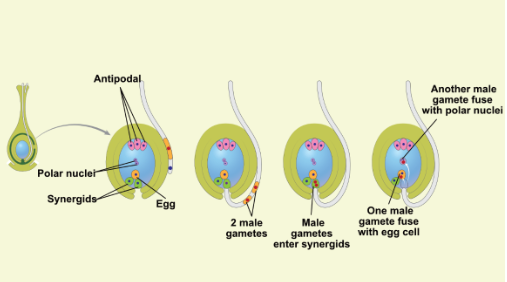Table of Contents
The process of fertilization in plants is a remarkable and intricate mechanism that ensures the continuation of their species. In angiosperms, the most diverse and widespread group of plants on Earth, a fascinating phenomenon known as double fertilization occurs. This distinctive reproductive strategy sets angiosperms apart and plays a crucial role in their life cycle. In this article, we delve into the captivating world of double fertilization in angiosperms, exploring its significance, process, and outcomes.
Introduction
Angiosperms, or flowering plants, dominate the plant kingdom with their incredible diversity and adaptability. What sets them apart from other plant groups is their innovative reproductive system, which involves double fertilization. This process is a testament to nature’s ingenuity in ensuring successful reproduction.
The Unique Reproductive System of Angiosperms
Angiosperms have evolved an advanced reproductive system that includes flowers. Flowers are not merely aesthetically pleasing; they are complex structures designed to facilitate pollination and fertilization. Within the floral structures, male and female reproductive organs are in close proximity, creating the perfect environment for double fertilization.

The Process of Double Fertilization
Double fertilization is a two-step process that occurs following pollination:
- One sperm cell from the pollen tube fuses with the egg cell in the embryo sac, forming a diploid zygote (2n). This zygote will eventually develop into the plant’s embryo, which gives rise to the new plant.
- The other sperm cell from the pollen tube fuses with two polar nuclei in the embryo sac, creating a triploid cell (3n). This triploid cell then undergoes multiple rounds of division, forming the endosperm. The endosperm is a nutrient-rich tissue that provides nourishment to the developing embryo in the seed.
The Outcomes of Double Fertilization
Double fertilization results in two significant events:
- Zygote Formation: The fusion of one male gamete with the egg cell forms a diploid zygote. This zygote undergoes mitosis and develops into the embryo, which will grow into the new plant.
- Endosperm Formation: The fusion of the other male gamete with two polar nuclei leads to the formation of a triploid cell. This triploid cell develops into the endosperm, a nutrient-rich tissue that provides essential nourishment to the developing embryo.
Significance of Double Fertilization
Double fertilization offers several advantages to angiosperms:
- Efficient Nutrient Utilization: By producing the endosperm only when fertilization occurs, angiosperms prevent wasteful energy expenditure on nutrient storage.
- Enhanced Offspring Survival: The endosperm provides essential nutrients for the developing embryo, increasing the chances of the offspring’s successful germination and growth.
- Reproductive Isolation: The separation of the fertilization process into two distinct steps helps prevent inbreeding and enhances genetic diversity within plant populations.
Conclusion
Double fertilization is a captivating reproductive strategy unique to angiosperms, highlighting the sophistication of their reproductive system. This intricate process ensures the efficient utilization of nutrients, enhances offspring survival and contributes to the genetic diversity of angiosperm populations. As we continue to unlock the secrets of plant reproduction, the phenomenon of double fertilization remains a testament to the remarkable adaptations that have allowed angiosperms to thrive and dominate terrestrial ecosystems worldwide.
FAQs on Double Fertilization in Angiosperms
What is double fertilization in angiosperms?
Double fertilization is a unique reproductive process in angiosperms (flowering plants) where two separate fertilization events occur within a single flower, resulting in the formation of both a zygote and endosperm.
How does double fertilization work?
Double fertilization involves the formation of a pollen tube that delivers two male gametes to the embryo sac within the ovule. One male gamete fuse with the egg cell to form a zygote, while the other male gamete fuses with two polar nuclei to form a triploid cell, which becomes the endosperm.
What is the significance of double fertilization?
Double fertilization is significant because it ensures efficient nutrient utilization, enhances offspring survival through the development of the endosperm, and contributes to genetic diversity by preventing inbreeding.
Does double fertilization occur in all plants?
No, double fertilization is a unique feature of angiosperms (flowering plants) and does not occur in other plant groups like gymnosperms.
What is the role of the endosperm in double fertilization?
The endosperm is a nutrient-rich tissue formed through double fertilization. It provides essential nutrients to the developing embryo and, in some cases, serves as a source of food for the germinating seedling.
Are both fertilization events in double fertilization necessary for plant reproduction?
Yes, both fertilization events are crucial for successful plant reproduction in angiosperms. The zygote develops into the embryo, while the endosperm provides vital nutrients for the developing embryo and seedling.
Does double fertilization result in the formation of two embryos?
No, double fertilization results in the formation of one embryo (zygote) and one endosperm within the same embryo sac.









